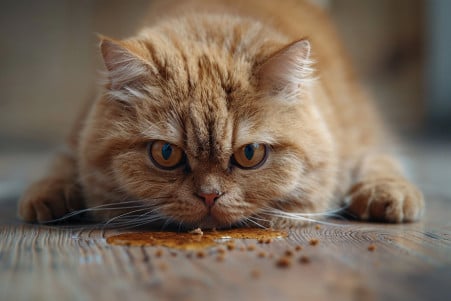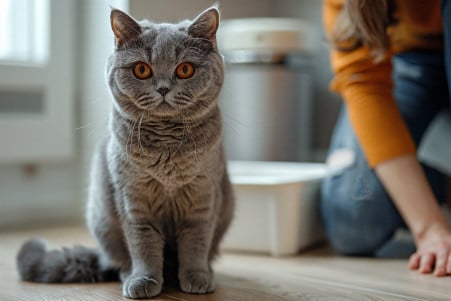Why Do Cats Poop on Beds? Causes and Solutions
20 March 2024 • Updated 19 March 2024

If you've ever walked into your bedroom to find that your cat has left you a smelly surprise on your bed, you know how frustrating and confusing this behavior can be. However, once you understand why your cat is doing it, you can take steps to stop it.
Cats poop on beds for a variety of reasons, including medical problems such as constipation and diarrhea, litter box aversion caused by a dirty or small litter box, and stress and anxiety, which can lead to inappropriate elimination. That said, with a little patience and some help identifying and addressing the cause, this behavior can be corrected.
To help you better understand this strange behavior, we've compiled a list of research-based information from reputable sources. This in-depth overview includes veterinary research on medical causes, studies on cat behavior and how it impacts litter box use, and evidence-based investigations into a variety of training methods that have been shown to help stop this frustrating behavior.
By the time you're done, you'll not only know why your cat is pooping on your bed, but you'll also have actionable tips to help you put an end to this unpleasant habit and get back to enjoying your relationship with your cat.
Why does my cat poop on my bed?
Medical Conditions and Health Concerns
Medical conditions are a leading cause of inappropriate elimination in cats, so it's important to rule these out before looking at behavioral causes. Gastrointestinal issues such as inflammatory bowel disease, food sensitivities, or parasites can cause increased urgency, diarrhea, and an inability to make it to the litter box in time.
According to the Cornell University Feline Health Center, urinary tract infections, kidney disease, diabetes, and thyroid disease can also contribute to litter box avoidance by increasing the frequency of urination and causing discomfort.
In older cats, arthritis or other mobility issues can make it difficult to get to and use the litter box comfortably. A comprehensive veterinary exam is important to rule out any medical issues that could be causing your cat to poop on your bed. If a medical issue is found, such as a gastrointestinal issue, urinary tract infection, or mobility issue, treating that issue may resolve the problem of inappropriate elimination without the need for further action.
If no medical issues are found, however, you may need to address potential litter box aversions, environmental stressors, or behavioral preferences to help your cat stop pooping on your bed. With time and a comprehensive plan, you can help your cat get back to using the litter box and restore peace in your home.
Litter Box Setup and Management
The ASPCA stresses the importance of having enough litter boxes for the number of cats in the home. They recommend having one box per cat plus one extra, which ensures that each cat has their own box and minimizes territorial disputes that can lead to inappropriate elimination.
The size and style of the litter box matter as well. Cats.com explains that cats prefer privacy, so covered boxes with doors may be more attractive. In addition, the box should be large enough to allow the cat to move around in it comfortably. Trying different types of litter can also help you figure out what your cat prefers since some cats may like finer or coarser textures.
Keeping the litter box clean is important too. A Feline Health Center article from Cornell University states that a dirty litter box can cause an aversion to the box and lead to house soiling. Cleaning the box daily and changing the litter out regularly can help keep odors at bay and make the cat's bathroom area more inviting.
Finally, the location of the litter box matters. If you put the boxes in quiet, low-traffic areas, your cat is more likely to use them. By paying attention to these litter box setup and management considerations, you can help ensure that your cat uses their litter box instead of your bed.
Stress and Environmental Factors
Stress and environmental factors can also play a role in a cat's decision to poop on the bed. As PetSafe® points out, cat urine can act as a "smelly name tag" that cats use to feel more comfortable when their owners are away. This can lead to a cat pooping on the bed to mark their territory and make it feel more like their own when they're feeling insecure or stressed.
Cats.com notes that common stressors like moving, the addition of a new pet, guests, and even loud noises can cause a cat to break their normal routine and poop on the bed. Cats are known for being sensitive to changes in their environment, and pooping on the bed can be a way for them to deal with the stress and anxiety that comes with those changes.
To help reduce stress and make the environment more comfortable, the Cat Behavior Alliance suggests adding environmental enrichment, like cat trees, scratching posts, and toys.
In addition, using calming pheromone products or supplements can help a cat feel more relaxed. It's also important to make sure the cat has a safe, quiet space to go when they're feeling stressed. Building a stronger bond with the cat through more play and interaction can also help reduce separation anxiety that may be leading to the behavior.
By recognizing and working to reduce the stress and environmental factors that may be at play, you can help your cat feel more comfortable and secure, and reduce the likelihood that they will poop on your bed in the future.
Clean and Deter Future Incidents
When it comes to poop, time is of the essence, says Consumer Reports. Their experts say that you should use an enzymatic cleaner to get rid of the smell and make sure that you treat the stain thoroughly. Cats.com says that you should start by removing any solid waste and then blot the area with paper towels to remove as much of the liquid as possible before applying the cleaning solution.
To make sure that your cat doesn’t come back to the same spot, Clorox® says that you can use deterrents like aluminum foil, double-sided tape, or citrus scents on the bed. They also suggest that you can block the cat’s access to the bed by closing the bedroom door or using pet gates until the behavior is corrected. On the other hand, Cats.com warns against using ammonia-based cleaners because the scent can attract your cat back to the area.
It’s important to make sure that you clean any soiled bedding and mattresses thoroughly to make sure that you get rid of any odors that might encourage your cat to continue to eliminate inappropriately. By using a combination of cleaning and deterrents, you can make sure that you discourage future incidents and help ensure that your cat’s retraining is successful.
Retraining and Reinforcing Proper Litter Box Usage
The Love & Hisses blog explains that the first step in retraining a cat to use the litter box is to isolate them in a small room, like a bathroom, with just their litter box, food, and water for several days. This way, the cat can be retrained to use the litter box and only the litter box. The wikiHow article also recommends placing the litter box in a quiet, low-traffic area with multiple exits so that the cat doesn't feel trapped.
Positive reinforcement is important during this time. As Cats.com notes, praising and rewarding the cat when it uses the litter box correctly can help ensure that the behavior continues. Slowly reintroducing the cat to the rest of the home, while watching for accidents, will help the cat relearn the proper litter box habits.
In addition, attractant litters and calming pheromone products, as suggested by Cats.com, can help with the retraining process by making the litter box more inviting. However, the Love & Hisses blog warns that it will take patience and diligence as it may take a while for the cat to get back into the habit of using the litter box.
By using these science-backed methods, you can help your cat overcome their inappropriate elimination and get your household back to normal.
Conclusion: Getting Back on Track with Your Cat
Dealing with inappropriate elimination in cats is a process that requires time, effort, and a combination of strategies. The first thing to do is to make sure that there are no medical issues that are causing the problem by taking your cat to the vet.
Gastrointestinal issues, urinary tract infections, and age-related mobility problems are just a few of the medical issues that can lead to a cat avoiding the litter box.
After medical issues have been ruled out, the next step is to make sure that the litter box is set up in a way that is conducive to your cat using it and to manage stress in the environment. This includes making sure that there are enough litter boxes, using the right kind of litter, and keeping the boxes clean. Stress can also be managed by minimizing changes in the environment and using pheromone products.
Cleaning and using deterrents are important in making sure that your cat doesn't continue to use the bed as a bathroom. This includes cleaning up messes as soon as they happen with an enzymatic cleaner and using deterrents like aluminum foil and citrus scents to keep your cat away from the bed. Finally, retraining and reinforcing positive litter box behavior through isolation, positive reinforcement, and gradual reintroduction can be helpful.
With time, effort, and a combination of medical and behavioral strategies, you can get back on track with your cat and repair your relationship.


